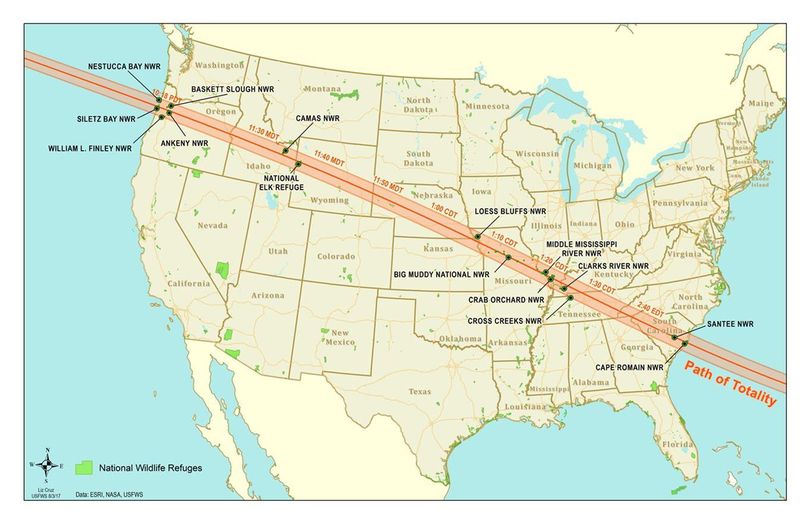Total eclipse path crosses 19 national wildlife refuges

SKYWATCHING -- National wildlife refuges are in the “path of totality” for the Aug. 21 total solar eclipse, the first in the United States since 1979.
The blackout will last less than three minutes, but by visiting one of 19 wildlife refuge in the path for the event you can extend the wild experience -- but lots of other people likely have the same idea.
The projected path of the August 21 event reaches from the Oregon Coast across the nation to the coast of South Carolina. A string of national wildlife refuges is in the prime viewing area.
Following is some useful information from the U.S. Fish and Wildlife Service.
Refuges in the direct path of the eclipse include:
Pacific Northwest (first U.S. viewing area)
Ankeny National Wildlife Refuge, Oregon
Mountain-Prairie
National Elk Refuge, Wyoming
Crescent Lake National Wildlife Refuge, Nebraska
Midwest
Loess Bluffs National Wildlife Refuge, Missouri
Swan Lake National Wildlife Refuge, Missouri
Middle Mississippi River National Wildlife Refuge, Illinois and Missouri
Cypress Creek National Wildlife Refuge, Illinois
Crab Orchard National Wildlife Refuge (PDF), Illinois
Southeast (last U.S. viewing area)
Clarks River National Wildlife Refuge, Kentucky
Cross Creeks National Wildlife Refuge, Tennessee
Cape Romain National Wildlife Refuge, South Carolina
Savannah National Wildlife Refuge, Georgia and South Carolina
Waccamaw National Wildlife Refuge, South Carolina
The U.S. Department of the Interior offers tips on how to catch the eclipse safely. Most importantly, avoid looking directly at the sun. The only time you can do that without risking permanent eye damage is when the face of the sun is totally obscured by the moon. Sunglasses or even eclipse-viewing glasses may not provide adequate protection.
One of the safest, easiest ways to view an eclipse is by projecting its image onto a piece of white paper.
On the ground, thousands of photographers will have their tripods and long lenses ready, in hopes of capturing images of the rare event. The University of California at Berkeley and Google hope to stitch some of these citizen science photos through the Eclipse Megamovie Project that can inform scientists with a continuous data set from coast-to-coast.
The Fish and Wildlife Service’s Pacific Northwest, with six publicly accessible refuges in the total eclipse path and some of the best inland weather prospects, is bracing for crowds. The region has a web page and blog about the event.
The Pacific Northwest refuges are working to welcome eclipse viewers while maintaining public safety.
- Each refuge will have designated public parking and viewing areas. The number of parking spots will vary by site or refuge complex. Please check with your local refuge for details
- Parts of refuges may be closed to protect threatened or endangered plants or animals or because these areas may pose safety or fire hazards. Please respect these limits.
- Refuges are open from dawn to dusk. Overnight camping or parking is not permitted.
- Because the eclipse is occurring during the height of wildfire season, plans may need to change at short notice to protect public safety.
Oregon Coast refuges (Siletz Bay and Nestucca Bay) will cap eclipse visitor numbers at 200 to protect habitat for the fragile Oregon silverspot butterfly. Refuge staff, volunteers and partners have been restoring that habitat for years to prepare for the reintroduction of the federally threatened butterfly at Nestucca Bay Refuge.
Thinking of heading to National Elk Refuge or nearby Jackson, WY? So are lots of others. Be sure to have your accommodations arranged prior to arrival. Camping and overnight parking are not allowed on National Elk Refuge. Bring ample food and water in case local supplies run short or traffic congestion makes supply runs difficult. The primary planning site for visitors to the Jackson Hole area that week is http://tetoneclipse.com/.
In southern Illinois, Crab Orchard Refuge is anticipating spillover from Moonstock, a solar eclipse-themed, four-day music festival set to take place nearby. The refuge will waive entrance fees that day. Look for more information on the refuge website as the date approaches.
Loess Bluffs National Wildlife Refuge, 30 miles northwest of St. Joseph, MO, will host a solar eclipse watch party. The event will feature information on nighttime wildlife as well as the eclipse. A limited number of viewing glasses will be available.
Some national wildlife refuges along the solar eclipse path offer camping.
New campsites on private lands are being developed to help meet demand for solar eclipse viewing crowds.
For public events and an eclipse 101, check out NASA online.
